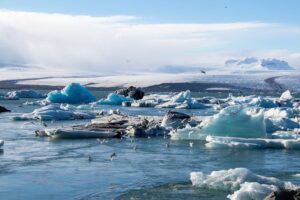Physical Address
23,24,25 & 26, 2nd Floor, Software Technology Park India, Opp: Garware Stadium,MIDC, Chikalthana, Aurangabad, Maharashtra – 431001 India
Physical Address
23,24,25 & 26, 2nd Floor, Software Technology Park India, Opp: Garware Stadium,MIDC, Chikalthana, Aurangabad, Maharashtra – 431001 India

The world’s glaciers, nature’s frozen giants, are vanishing before our eyes. In 2023 alone, they suffered their greatest water loss in over 50 years, sending a warning about the urgency of climate change. Now, the United Nations has declared 2025 the International Year of Glaciers’ Preservation, urging the global community to take bold action to safeguard these vital water reservoirs and the ecosystems and people who depend on them.
Glaciers and ice sheets currently hold around 70% of the world’s freshwater. However, their rapid melting threatens not only ecosystems but also the water security and livelihoods of millions of people globally. The UN’s initiative comes as the world faces an environmental and humanitarian crisis of unprecedented scale, driven by the relentless pace of glacier loss.
When Ice Melts, Lives Shatter
The World Meteorological Organization (WMO) has sounded the alarm, reporting that glaciers experienced their greatest water loss in over half a century in 2023. This marked the second consecutive year in which all glaciated regions worldwide reported significant ice loss. Countries like Switzerland exemplify the gravity of the situation, having lost 10% of their glacier mass between 2022 and 2023 alone.
Celeste Saulo, WMO Secretary-General, stressed the urgency of the crisis:
“Melting ice and glaciers threaten long-term water security for many millions of people. This international year must be a wake-up call to the world.”
Her statement highlights the global implications of glacier loss, which extend far beyond the regions directly impacted. From rising sea levels to disrupted weather patterns, the cascading effects of melting glaciers pose existential threats to communities worldwide.
The Role of Glaciers in Climate Regulation
Glaciers are more than just frozen landscapes; they play a critical role in regulating the Earth’s climate. These icy giants reflect sunlight, helping to keep the planet cool, while also acting as reservoirs that release freshwater during warmer months. For countless communities, especially in regions dependent on glacial meltwater, these frozen resources are a lifeline.
However, as global temperatures rise, glaciers are melting faster than ever before, disrupting ecosystems, agriculture, and water supplies. Dr. Carolina Adler of the Mountain Research Initiative captured this stark reality succinctly:
“Glaciers don’t care if we believe in science – they just melt in the heat.”
Key Initiatives for 2025
The International Year of Glaciers’ Preservation will focus on several key initiatives aimed at addressing the crisis:
1. Raising Global Awareness
A primary goal is to enhance public understanding of the essential role glaciers, snow, and ice play in maintaining climate stability and supporting ecosystems. Public campaigns, educational programmes, and community engagement efforts will aim to make the issue more relatable and urgent for people around the world.
2. Advancing Scientific Research
The initiative prioritises strengthening scientific knowledge through programmes like the WMO’s Global Cryosphere Watch. Enhanced monitoring and data collection are essential to guide effective climate action and improve predictions about the future impacts of glacier loss.
3. Strengthening Policy Frameworks
Integrating glacier preservation into global and national climate strategies is another critical focus. This includes aligning preservation efforts with the Paris Agreement and other international commitments to limit global warming. Governments are being urged to incorporate glacier-related concerns into their broader climate action plans.
4. Mobilising Financial Resources
Securing financial resources is essential to support adaptation and mitigation efforts, particularly for vulnerable communities directly affected by glacier loss. Investments will be directed toward infrastructure, disaster preparedness, and sustainable water management systems to help these communities adapt.
5. Engaging Youth and Local Communities
The participation of youth and local communities is seen as pivotal in ensuring the success of glacier preservation efforts. Grassroots initiatives and youth-led advocacy campaigns will play a crucial role in driving change at the local level and fostering a sense of collective responsibility.
The Humanitarian Implications of Glacier Loss
The loss of glaciers is not just an environmental issue; it is a humanitarian one. Communities that rely on glacial meltwater for drinking, irrigation, and hydropower are already facing significant challenges. As water supplies dwindle, competition for resources could escalate, leading to conflicts and forced migration.
Moreover, rising sea levels caused by melting glaciers threaten to inundate coastal cities and small island nations, displacing millions of people. These challenges are compounded by the increased frequency and intensity of extreme weather events, which disrupt food supplies and exacerbate poverty.
A Global Responsibility
The declaration of 2025 as the International Year of Glaciers’ Preservation represents a crucial opportunity for the world to unite in addressing this pressing crisis. However, meaningful progress will require collective action at all levels – from individual behaviour changes to international policy reforms.
As glaciers continue to disappear, the window of opportunity to act is rapidly closing. The international community must rise to the occasion, recognising that the preservation of glaciers is not just about protecting the environment but about safeguarding the future of humanity.
By raising awareness, advancing scientific understanding, and mobilising resources, the International Year of Glaciers’ Preservation aims to inspire transformative action. As Dr. Adler aptly stated, “Glaciers don’t care if we believe in science – they just melt in the heat.” It is up to us to ensure that this melting does not signify the dissolution of our collective future.
References
https://news.un.org/en/story/2025/01/1159236
https://news.un.org/en/story/2025/01/1158891
https://wmo.int/topics/cryosphere/launch-of-website-international-year-of-glaciers-preservation-2025
Banner Image: Photo by Gabriel Kuettel
Comments are closed.
Your style is so unique compared to many other people. Thank you for publishing when you have the opportunity,Guess I will just make this bookmarked.2
Hi too all, how iis thee wgole thing, I think every onne iss getting
mkre froim this website, and ykur views aare fastidious
in upport off nnew people.